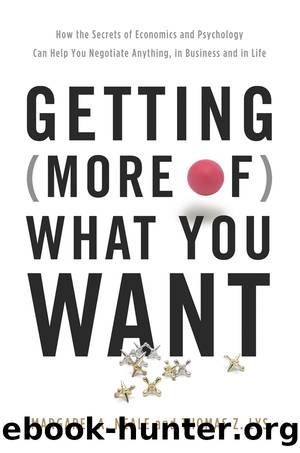Getting (More Of) What You Want : How the Secrets of Economics and Psychology Can Help You Negotiate Anything, in Business and in Life by Neale Margaret A.; Lys Thomas Z

Author:Neale, Margaret A.; Lys, Thomas Z.
Language: eng
Format: mobi
Publisher: Perseus Book Group
Published: 0101-01-01T00:00:00+00:00
CHAPTER NINE
CONCEDE OR ELSE!
The Influence of Promises and Threats
Negotiators often attempt to influence their counterparts by issuing threats or making promises. For example, they might threaten to walk away if their counterpart does not concede on an issue, or even threaten to take an action that is outside the negotiation; for example, unions typically threaten to strike, thereby imposing costs on management if they donât concede. On the other hand, negotiators also may promise to take an action that is outside the temporal frame of your current negotiation, such as: âIf you concede on this issue, I will make sure that everyone knows what a great product you sell.â
In this chapter, we focus on promises and threats of actions that occur after the negotiation has concluded as forms of influence. Thus, when the target of the threat or promise concedes, he does not know if the issuer will actually carry out the threat or honor the promise.
Obviously, to be effective at influencing the target, promises and threats have to be credible; that is the target must believe that, if he concedes, the issuer will make good on the promiseâor carry out the threat, if he does not. Conversely, if the target believes that the threat or the promise is not credible (i.e., that it will not be carried out), then he should simply ignore that threat or promise. Of course, it also follows that issuers should only threaten or promise when those actions are perceived as credible by the target and thus likely to have the desired influence.
Weâll begin by discussing the differences and the similarities between threats and promises. Then we focus on what makes promises and threats credible. We start with the assumption that both issuer and target act reasonably (or in Thomasâs view, rationally). We will then expand our analysis to include the psychological perspective.
PROMISES VERSUS THREATS
Both threats and promises are used to influence your behavior. For example, airlines routinely promise their best customers access to seats with more legroom and upgrades to first class. Those promises are contingent on availability and, thus, not really enforceableâyet these benefits are effective in influencing customersâ behavior only if they believe that the airline will make good on that promise. It is the same in a negotiation; promises are useful to the extent that you believe that your counterpart will honor her promises.
Just as in the case of promises where your counterpart can offer attractive inducements, she may threaten some other action that is costly to you if you do not concede. However, from your perspective (as the target of the action), an obvious difference between threats and promises is that if carried out, threats impose costs on you while promises offer benefits.
Carrying out either a threat or a promise, however, is costly to the issuer. Indeed, although it seems natural to focus on the costs and benefits from the perspective of the target of these attempts to influence, as we discuss next, what matters most for the credibility of the threats and promises themselves are actually the costs from the perspective of the issuer.
Download
This site does not store any files on its server. We only index and link to content provided by other sites. Please contact the content providers to delete copyright contents if any and email us, we'll remove relevant links or contents immediately.
Storytelling for dummies by Andrea Fontana(1472)
Effortless by Greg McKeown(1398)
The Practice by Seth Godin(1379)
Mastering Blockchain by Lorne Lantz(1372)
Blockchain Quick Reference by Paul Valencourt & Samanyu Chopra & Brenn Hill(1126)
Mastering Blockchain by Lorne Lantz & Daniel Cawrey(892)
How to Lead by David M. Rubenstein(799)
The wind in the willows by Kenneth Grahame(777)
The Ape in the Corner Office by Richard Conniff(771)
Handbook of Big Data Analytics by Unknown(693)
Social Media Engagement For Dummies by Aliza Sherman(689)
FunRetrospectives: activities and ideas for making agile retrospectives more engaging by Paulo Caroli & Tainã Caetano Coimbra(675)
Getting Started with Data: The first book you should read to successfully get along with data. by Menegatti Gabriel & Team Simbiose Ventures(674)
Taking Care of Yourself (HBR Working Parents Series) by Harvard Business Review(674)
Business Storytelling For Dummies by Unknown(651)
Evernote for Self Publishing: How to Write Your Book in Evernote from Start to Finish by Jose John(642)
Help! My Facebook Ads Suck-- by M. D. Cooper & Jill Cooper(634)
Genius by Choice: Your unconventional A–Z handbook to enhance your learning process by Remondino Giulia S(620)
A Leader Listens by Ajay Banga(619)
